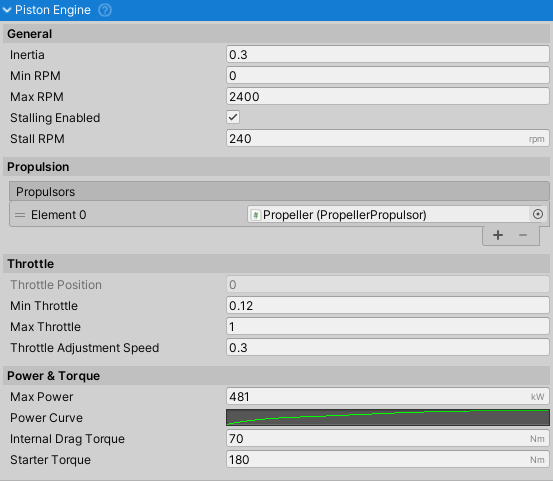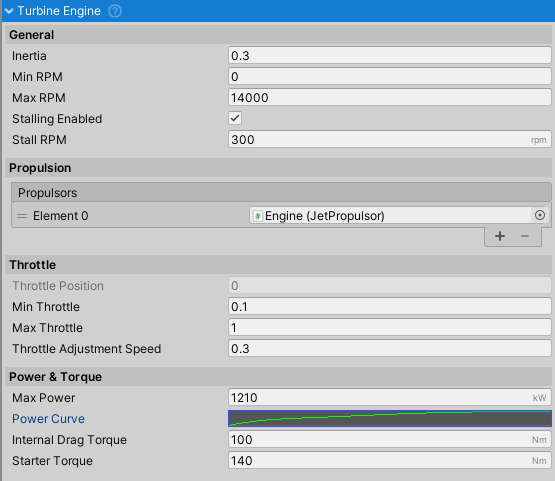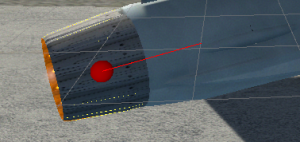Propulsion in NWH Aerodynamics consists of two main groups of classes; engines and propulsors. The engines are power generators while propulsors are power consumers. Examples of engine to propulsor pairings are:
TurbineEngine⇒JetPropulsorTurbineEngine⇒PropellerPropulsorPistonEngine⇒PropellerPropulsor- …
All engines can theoretically be paired to all propulsors.
Engines
Engines can be attached to any child object of an AircraftController but it is usually a good idea to create a dedicated empty GameObject for it. All classes inheriting from AircraftEngineBase have some common fields:
General
Inertia- determines how fast the engine will spin up/down. A larger value will take longer.Min RPM- minimum engine RPM. Different fromStall RPMas this is the minimum RPM the engine can turn at.Max RPM- maximum RPM the engine can achieve.Stalling Enabled- is it possible to stall the engine by running it at lower RPM thanStall RPM.Stall RPM- RPM under which the engine does not generate enough power to overcome internal friction causing it to stall. When starting the starter needs to be kept active until the RPM value goes overStall RPMor the engine will die.
Propulsion
Propulsors- list of objects inheriting fromPropulsorBasethat will get powered by this engine. This will be a single propulsor in most cases, such asPropellerPropulsororJetPropulsor. If multiple propulsors are attached, the power will be split between them.
Throttle
Min Throttle- minimum (idle) throttle. If the value is too low the engine might stall instead of idling.Max Throttle- maximum engine throttle. In most cases 1. Some aircraft can however go over 100% throttle for short periods of time, such as takeoff.Throttle Adjustment Speed- the speed at which the throttle is adjusted while increase/decrease throttle buttons are held.
Power & Torque
Max Power- maximum power the engine can generate.Power Curve- normalized power/RPM curve. Y axis represents power [0,1] and X axis represents RPM [0,1].Internal Drag Torque- torque as a result of engine losses. Larger value will result in engine that spins down faster but might not idle if the drag torque is larger from the generated idle torque.Starter Torque- torque generated by the starter motor. Larger value will spin up the engine faster. Start Time will also depend onInternalDragTorqueandInertia.
Piston Engine
Turbine Engine
Propulsors
Propulsors in NWH Aerodynamics take power from the engines and converts it into thrust.
All Propulsors have some common fields:
Thrust Point- a position at which the thrust will be applied. Marked with a red sphere.Thrust Direction- a direction in which the thrust will be applied. Marked with a red line (pointing towards the direction of force).Inertia- the inertia of the propulsor. A higher value will result in an engine/propulsor that is slower to spin up/down.Gear Ratio- some couplings between the engine and propulsor have a gearing ratio. A value of 2 means that for each turn of the engine the propulsor will do two turns.Rotation Direction- direction of rotation of the propeller.Reverse Thrust Coefficient- if the propulsor is spinning in reverse to the intended direction or the reverses have been applied the thrust will be multiplied by this value as the reverse thrust is normally lower than the forward thrust.




